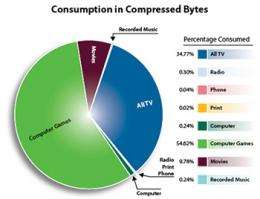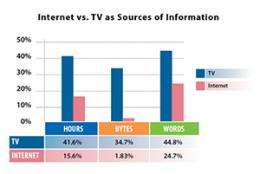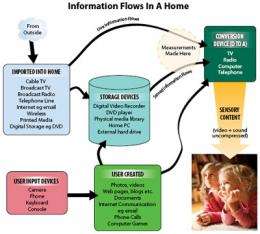UCSD Experts Calculate How Much Information Americans Consume

(PhysOrg.com) -- U.S. households consumed approximately 3.6 zettabytes of information in 2008, according to the "How Much Information? 2009 Report on American Consumers," released today by the University of California, San Diego. One zettabyte is 1,000,000,000 trillion bytes, and total bytes consumed last year were the equivalent of the information in thick paperback novels stacked seven feet high over the entire United States, including Alaska.
The How Much Information? project is creating a census of the world’s information in 2008. The study measured information consumed by U.S. consumers in and outside the home for non-work related reasons, and included the gamut of information sources, including going to the movies, listening to the radio, talking on the cell phone, playing video games, surfing the Internet, and reading the newspaper, among other things.
“This report is a snapshot of what the information revolution means to the average American on an average day, who consumes 34 gigabytes and 100,000 words of information,” said report author Roger Bohn, Director of the Global Information Industry Center at UC San Diego’s School of International Relations and Pacific Studies. “The total volume of 3.6 zettabytes consumed last year is much larger than previous studies have reported, partly because they measured different views of information, such as information creation rather than consumption. Also, nobody had looked at the role of computer games, which generate a staggering number of bytes.”
The new report estimates that between 1980 and 2008, bytes consumed increased 350 percent, for an average annual growth rate of 5.4 percent. According to the report, the average American’s information consumption of 34 gigabytes a day is the equivalent of about one fifth of a notebook computer’s hard drive, depending on the model.
Hourly statistics confirm that a large chunk of the average American’s day is spent watching television. The new report estimates that on average 41 percent of information time is watching TV (including DVDs, recorded TV and real-time watching). American consumers watched 36 million hours of television on mobile devices each month - a number that, while expected to grow, is a fraction of the hours spent watching television at home.

Based on bytes alone, however, computer games are the biggest information source totaling 18.5 gigabytes per day for the average American consumer, or about 67 percent of all bytes consumed. Approximately 80 percent of the population plays some kind of computer game, including casual games such as Bookworm, Tetris and social networking games.
“Games are almost universal, but most of the gaming bytes come from graphically intensive games on high-powered computers and consoles, which have the equivalent of special-purpose supercomputers from five years ago,” said Bohn. “Games today generate their bytes inside the home, rather than having to transmit them over cables into the house, but gaming is increasingly moving online.”
Americans spent 16 percent of their information hours using the Internet (second only to TV’s 41 percent). With the proliferation of email, instant messaging and social networking, the Internet today dominates two-way communications, with more than 79 percent of those bytes every day.
Despite rapid growth, consumption of new media such as YouTube videos, text messaging or games on smartphones is still outpaced by traditional media.
“There are several hundred million TV sets in the U.S., and depending on whom you ask, about 50 million smartphones,” explained report co-author James Short, research director of the Global Information Industry Center. “And new media devices are increasingly personal devices - mobile phones, Kindles and handheld gaming devices - with small screens and relatively low resolution, limiting the number of bytes consumed.”
Looking to the future, the report’s authors point to current patterns of information consumption that will change the information landscape by 2015. In addition to the expected widespread use of HDTV, mobile television and video over the Internet have the potential to revolutionize where American consumers receive their visual information.

According to the study, the 3.6 zettabytes of total information used by Americans in their homes far exceeds storage or transmission capacity. For example, the total is roughly 20 times more than what can be stored at one time on all the hard drives in the world. Less than two percent of the total information was transmitted over the Internet.
"What is clear is that we consume orders of magnitude more information than can be stored on hard drives or transmitted over today's Internet," said Internet pioneer Larry Smarr, Director of the California Institute for Telecommunications and Information Technology, a partnership of UC San Diego and UC Irvine. "Even small changes in how Americans consume information would have serious implications for network planners and require large-scale investments."
To allow comparisons with earlier studies, the UC San Diego report’s authors devised mathematical formulas to convert all information statistics into words, bytes and the number of hours spent consuming information.
This initial report focuses on the U.S. consumer sector (both inside and outside the home, including use of cell phones and movie-watching). Future reports will focus on information in the U.S. workplace, in other regions, and different types of information (such as machine-to-machine data that is analyzed automatically and may never be seen by human eyes).
More information: The report, “How Much Information? 2009 Report on American Consumers”, is available online and can be downloaded in PDF format at hmi.ucsd.edu/howmuchinfo.php
Provided by University of California - San Diego (news : web)

















